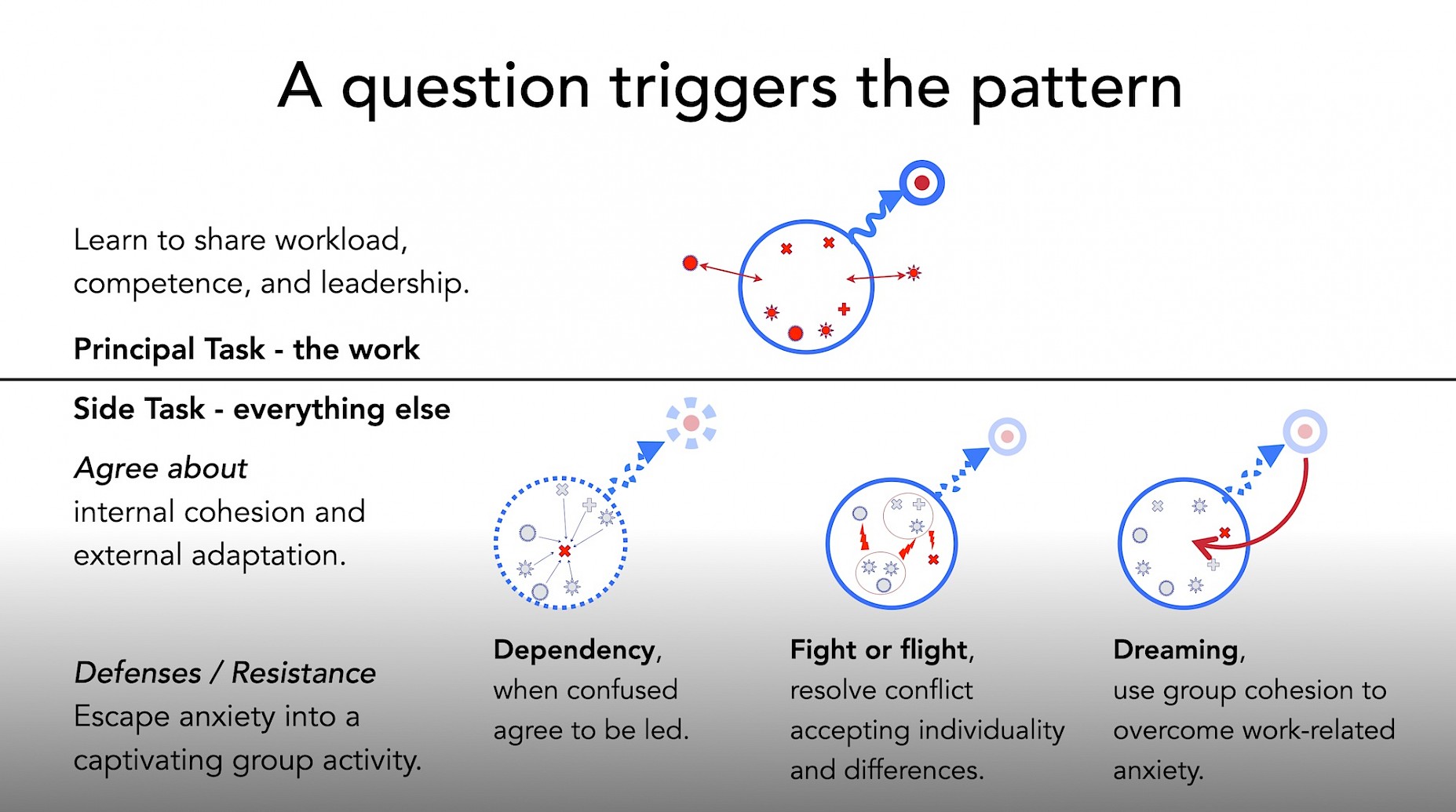Forming, Storming, Dreaming, Performing
14.8.2023 — Tuckman's orming is an interesting theory but not useful for practical coaching. Knowing how and why things really happen gives tools for concrete interventions.

I repeatedly see superficial buzz related to the developmental "Orming" phases by Tuckman. Muddling it with the "Team development curve" by Katzenbach and Smith is plain delusional. Our post offers a realistic explanation of how and why things happen, based on coaching teams and organizations for 25+ years. (And actually reading the articles.)
Background
1965 Tuckman published a meta-analysis of group development and coined a developmental model with phases. As often happens, the poetic terms conquered the world: Forming, Storming, Norming, Performing. The following research could not verify the sequential model and developed some alternatives. Still, the Tuckman model has become the most popular explanation of group development.
There are over 20 serious attempts to explain group development since the 1950s, recognized by the psychology community. (Pfeiffer Library Volume 25, 2nd Edition, p 165) These models, however, do not address the magical development of a bunch of individuals developing group cohesion and finally working as one team. Susan Wheelan is the only researcher I have found to explain this development well.
Tuckman's article and most of the following work focus on external behavior, not making sense of why and how the observed patterns happen. This makes the mainstream explanations maybe interesting but not useful for situational leadership.
For example, if you recognize critical talk in a relatively young team, how does the Tuckman model help you? What is going on, why, and what to do as a leader or team member? Or if the team indulges in fantasies while challenging work awaits. What would be a helpful intervention?
Tuckman corrected
Already at the times of Tuckman's research, the idea of team development phases was floating around in group dynamics traditions, which propose the following insight.
There are no phases. It is not a role game leveling model. Instead, a question or challenge of the team triggers a pattern. The team goes through shorter and longer cycles of Forming-Performing-Storming-Forming-Dreaming-Performing-...
However, there is a learning curve because specific questions tend to emerge in the beginning. Also, the patterns are easily explained in a sequence, as in the title picture, where the team steadily learns to Perform, to do the work. Whenever there is a problem with group dynamics, the team spends some time solving it and continues to Perform a little bit better than before the conflict or confusion. Observe that it is not an investment curve with a big dip in the beginning.
Forming - Agreeing to be led
In the beginning, the team is confused and needs to find alignment in order to work together. The group seeks a situational leader who would solve the confusion and agrees to be led by the chosen leader. Teams often struggle trying to find a good enough situational leader. Anyone - a nominated one, Scrum Master, or team member - can skillfully take the temporary leader position and help the team to organize.
The team is born only when everyone agrees to be led by the chosen leader. Richard Hackman claims that launch creates 30% of a team's success, based on his 40 years in another research path.
Later, a situational leader appropriate to the situation is chosen whenever the team faces a challenge that requires working as one team.
The team often exaggerates the greatness of the chosen leader, which correlates with the group dynamic pattern dependency. You can often recognize this pattern when team members ask naive questions from the chosen leader only to emphasize her greatness.
The related antipattern is that the team is stuck with the same leader forever, limiting performance, passivating the team members, and overloading the leader. This happens easily in organizations with hierarchical power structures and formal leader roles. A skillful formal leader can create good teamwork by sharing leadership.
The team goes on to Perform as facilitated by the chosen leader.
Storming - Balancing individuality and alignment
As the team gets work done, the understanding of realities increases, and disagreements surface. Safety increases, and needs for individuality and differences emerge, causing conflicts and critical feelings.
It is a no-brainer that the situational leader needs to solve conflicts. The team has all kinds of practical disagreements, but an argument is "Storming" only to the extent it is balancing alignment vs. individuality. A skillful situational leader solves any conflict so that individuality and alignment are balanced and differences accepted. This enables people to work using their full capacity.
The questions of Storming are always there. They might cause conflicts or pass smoothly. If they do not surface, a wise leader brings them up.
When solving conflicts, a good situational leader shows strength and creates safety by pulling the critique toward herself. Weak or incompetent leadership in these situations may stall the team development or lead to team dysfunctions like Scapegoat syndrome or chronic conflict.
The team continues to Perform with more diverse approaches.
Dreaming (was Norming) - Overcoming work-related anxiety
Only after balancing alignment and individuality, the team is able to work as one team. Now the team - as one team - starts to see the external challenges and gathers courage from group cohesion. It dreams about success, even unrealistically, and gradually turns into planning.
The blessing of this pattern is overcoming work-related anxiety, removing friction and hesitation, and finding unwavering commitment. It raises the feeling of safety to a new level and enables Flow working state for the members.
Tuckman gave a misleading name, "Norming," for this pattern when looking at superficial behavior. Exaggerated assimilation to behavioral norms signals cohesion and is easily misinterpreted as defensive behavior by external observers. Without "Dreaming and Thinking" together, the team would break, some would fade, and individual heroes would take all responsibility. For this reason, I can not stomach to call this Norming but need to use a more appropriate name Dreaming.
A good situational leader uses dreaming and storytelling to support the team in gathering courage and then facilitates feedback from reality.
The related dysfunction is that team lives only in dreams and happily does the wrong thing. This happens easily when the feedback is weak, like with management teams. Patterns like Groupthink and False communion (Happy family) explain this further.
The team bravely goes and Performs.
Performing - Getting the work done
Only after solving the questions of alignment and individuality, do we have a mature team that is able to work smoothly, support its members, reflect and improve itself as a team, and accept process coaching.
When Performing, the team learns to share workload, competence, and leadership. It cares about the shared space in practice, deepening trust and emotional attachment. The team members have the autonomy and support to work optimally. A good coach or situational leader supports the team's learning process with process coaching.
The team learns to Perform better and better.
A question triggers the pattern
These developmental patterns do not happen in big phases, but are triggered by an emerging challenge. There is no big dip in "Storming" but gradual learning throughout the life-cycle. There are small dips when solving different practical problems, resting, waiting for help, and agreeing about the internal developmental questions. This removes Tuckman's clumsy explanation of "falling back" to an earlier phase.
Group dynamics research is interested about how teams work, and what they do when avoiding work. Teams need to use optimal effort for solving the group dynamics questions. Too little stalls the improvement. Too much is defensive avoidance of the work and reality.
Wilfred Bion was the grand old man of group research. Around 1940's he coined "Basic Assumption Behavior", three communication patterns for any group in interaction: Dependency, Fight-flight, and Pairing. This theory certainly influenced Tuckman's article since Dependency maps to Forming and fight-flight to Storming. Pairing might happen while Dreaming. Among other creative defenses, groups may avoid work by indulging in these captivating patterns.


